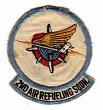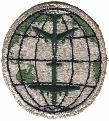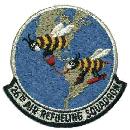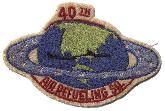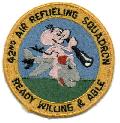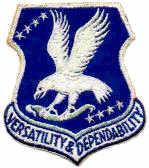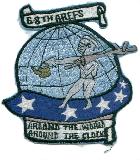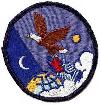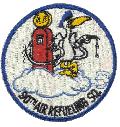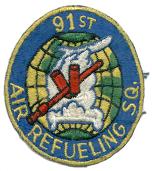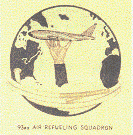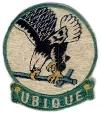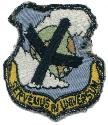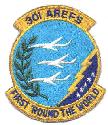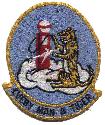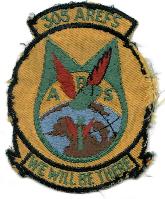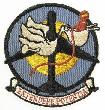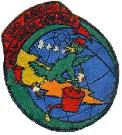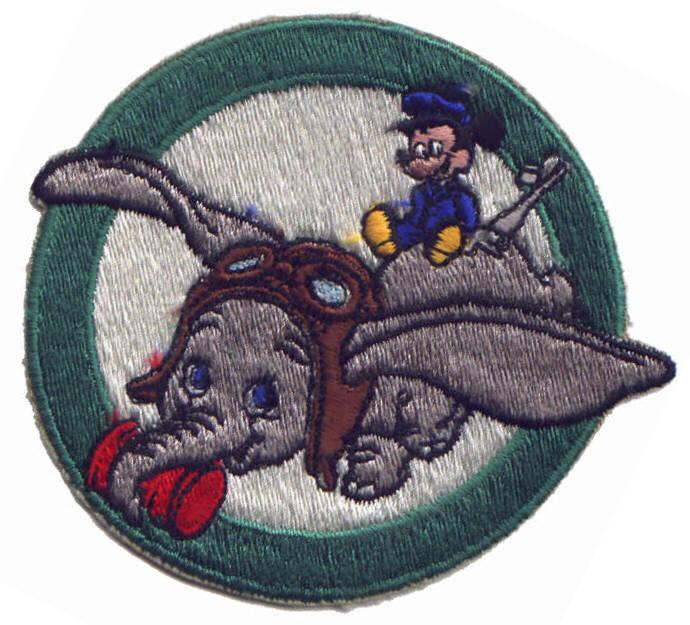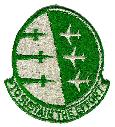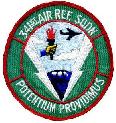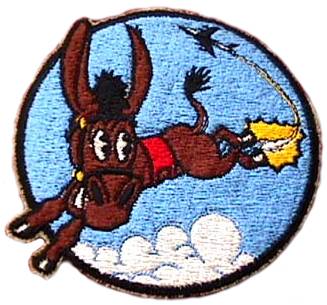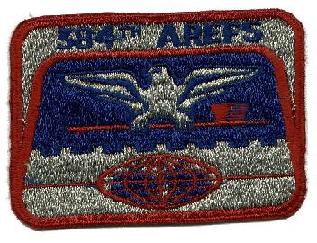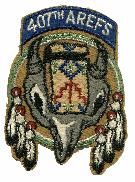93rd Air Refueling Squadron
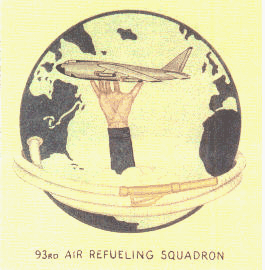
____________________________________________________________________
Constituted on 2 Feb 1949 to be a KB-29 squadron.
KB-29P
93rd Bombardment Wing (Medium)
Castle AFB, California
Oct 1950-Nov 1953
KC-97G
93rd Bombardment Wing (Heavy)
Castle AFB, California
Dec 1953-Jul 1957
KC-135A
93rd Bombardment Wing (Heavy)
Castle AFB, California
Jun 1957-1986
KC-135A/R
93rd Bombardment Wing
Castle AFB, California
1986-31 Mar 1995
KC-135Q/R/T
Fairchild AFB, Washington
92nd Air Refueling Wing
31 Mar 1995-Present
____________________________________________________________________
EMBLEM. Description. On a sky blue disc, with stylized world land mass markings green, a cubit arm issuing from a white cloud formation on the base of the disc, the hand in natural flesh tones, the arm habited of the second color; the hand supporting a jet type silver-gray aircraft with red markings; surmounting all and encircling the base of the disc, a hose attachment anchored in the United States, the nozzle pointing to the heraldic sinister of the disc.
Significance. The emblem symbolically represents the mission of the squadron. Specifically, the following items are representative of the mission: the background is a globe indicating a capability of worldwide operations; the hose identifies the air refueling mission; the hose is anchored in the United States, but encircles the globe and thus also indicates capability; hand supporting jet type aircraft displays our support role of bombardment aircraft; the predominance of the green coloring reflects our assigned color, utilized as identification on our aircraft, flight caps, etc. Approved on 22 Jun 1955. Negative Number: 152926 AC.
Lineage.
Constituted 493d Bombardment Squadron (Heavy) on 19 Sep 1942. Activated on 25 Oct 1942. Redesignated 493d Bombardment Squadron, Heavy, on 6 Mar 1944. Inactivated on 6 Jan 1946. Consolidated (19 Sep 1985) with 93d Air Refueling Squadron, Medium, which was constituted on 2 Feb 1949. Activated on 1 Mar 1949. Redesignated: 93d Air Refueling Squadron, Heavy, on 1 Feb 1955; 93d Air Refueling Squadron on 1 Sep 1991. Inactivated on 31 Mar 1995. Activated on 31 Mar 1995.
Assignments
7th Bombardment Group, 25 Oct 1942�6 Jan 1946. 93d Bombardment Group, 1 Mar 1949 (attached to 93d Bombardment Wing, 15 Jul 1950�30 Jan 1951 and 10 Feb 1951�15 Jun 1952); 93d Bombardment Wing, 16 Jun 1952; 93d Operations Group, 1 Sep 1991; 398th Operations Group, 1 Jun 1992�31 Mar 1995. 92d Operations Group, 31 Mar 1995�.
Stations.
Karachi, India, 25 Oct 1942; Pandaveswar, India, 7 Jan 1943; Tezgaon, India, 17 Jun 1944; Pandaveswar, India, 5 Oct 1944 (detachment at Luliang, China, 17 Dec 1944�26 Jan 1945); Dudhkundi, India, 31 Oct 1945; Kanchrapara, India, 19 Nov 1945; Camp Angus (near Calcutta), India, 25 Nov�7 Dec 1945; Camp Kilmer, NJ, 5�6 Jan 1946. Castle AFB, CA, 1 Mar 1949�31 Mar 1995 (operated from Upper Heyford RAF, England, 9 Dec 1951�6 Mar 1952; Davis-Monthan AFB, AZ, 1 Apr�15 May 1954; Ernest Harmon AFB, Newfoundland, 29 Jun�14 Aug 1954; Thule AB, Greenland, 19 Jan�c. 15 Mar 1955; Elmendorf AFB, AK, 2 Nov 1955�5 Jan 1956 and 27 Sep�c. 24 Dec 1956). Fairchild AFB, WA, 31 Mar 1995�.
Aircraft.
B�24, 1943�1945. KB�29P, Oct 1950�Nov 1953; KC�97G, Dec 1953�Jul 1957; KC�135, Jun 1957�.
Operations.
Activated in nonoperational status at New Delhi or Karachi (sources differ), India, on 25 Oct 1942. Moved to Pandaveswar on 7 Jan 1943 and became operational with B-24s. Commenced combat operations on 26 Jan 1943. Attacked communications targets (roads, railroads, etc) in central and southern Burma, all without fighter escort due to the long distances involved. Primary targets were oil refineries, docks, depots, enemy airfields, marshalling yards, bridges, locomotive repair sheds, naval vessels, and troop concentrations. Moved to Tezgaon, India, on 17 Jun 1944, and assumed a new mission: transporting high-octane gasoline over Himalayan �Hump� to bases in China. This mission lasted until 5 October, at which time the squadron moved back to Pandaveswar to resume bombing missions in Burma and Thailand. A detachment of the 493rd Squadron operated from Luliang, China, 17 Dec 1944-26 Jan 1945, hauling gasoline to Suichwan, China.
The squadron proper began practice with Azon bombs, which proved very effective against bridges and rail lines. In early 1945 the squadron concentrated on attacks against the Burma-Thailand railroad, the most important line left to the enemy in Burma. The squadron also dropped propaganda leaflets, June-September 1945. After fighting ended in Burma the 493rd Bomb Squadron was ordered to practice Azon bombing in China, but soon �alerted� for inactivation. With its parent (7th Bomb Group) the 493rd staged through Dudhkundi, Kanchrapara, and Camp Angus (near Calcutta), departing Calcutta aboard the USS General Black on 7 Dec 1945. The vessel reached the U.S. on 5 Jan 1946 and the squadron inactivated at Camp Kilmer, NJ, the following day.
Activated on 1 Mar 1949 as the 93rd Air Refueling Squadorn, Medium, but was not manned until September 1950. Received KB-29P tankers, October 1950-Jun 1951. Became combat ready in October 1951. The 93rd ARS deployed to Upper Heyford RAF Station, England, 6 Dec 1951-6 Mar 1952, while the parent wing was at nearby Mildenhall RAF Station. The squadron supported Operation FOX PETER II, the movement of the 31st Fighter-Escort Wing from the U.S. to Japan, in July 1952 using 11 KB-20Ps at Guam and Kwajalein to refuel some 58 F-84G fighters on their way to the Korean War. The squadron converted from KB-29s to KC-97G tankers in November and December 1953. It undertook several oversea deployments, to Newfoundland, Greenland, French Morocco, and Alaska, in 1954-1956.
The 93rd ARS began training its aircrews to operate KC-135s in May 1957. Began receiving KC-135s on 28 Jun 1957, three days after converting to KC-135 aircrew training as primary mission. Possessed 19 tankers in December 1957 and 39 by May 1958. Effective 1 Jul 1959, the resources of the 93rd ARS were divided with the 924th ARS, which unit assumed the SAC KC-135 aircrew training mission with 15 aircraft. The 93rd ARS, at the same time, resumed full-time air refueling with 20 KC-135s. This status lasted until 21 Aug 1963, when the 93rd ARS ceased standing alert and prepared to resume full-time KC-135 aircrew training. On the 26th of August the 93rd once again began KC-135 aircrew training as its primary mission. It retained Emergency War Order (EWO) commitments along with its training mission, but did not stand alert.
The squadron�s mission remained basically the same until 31 Mar 1995. Thousands of Strategic Air Command and some Air Mobility Command KC-135 aircrews received flight training from the 93rd ARS.
Each crew (pilot, copilot, navigator, and boom operator), after academic training with the 4017th Training Squadron at Castle, received 45 days of flight training from the 93rd ARS. The squadron also provided specialized training of shorter duration to senior officers (such as wing commanders). For a period the 93rd ARS also sent instructor teams to locations where Reserve and Air National Guard units were converting to tanker operations to help in-house training programs. On rare occasions the 93rd had deployed some of its aircraft and crews to meet its own EWO commitments or to meet needs exceeding the capability of the 924th ARS. A few such deployments occurred in 1980.
Portions of the squadron deployed in support of operations in Southwest Asia, 2 Sep 1990�10 Mar 1991.
Honors
Service Streamers. None.
Campaign Streamers. World War II: India-Burma; Central Burma; China Defensive. Southwest Asia: Liberation and Defense of Kuwait.
Armed Forces Expeditionary Streamers. None.
Decorations. Distinguished Unit Citation: Thailand, 19 Mar 1945. Air Force Outstanding Unit Awards: 1 Jan 1956�1 Jul 1959; 1 Jun 1962�1 Apr 1963; 1 Apr 1973�30 Jun 1974; 1 Jul 1983�30 Jun 1985; 1 Jul 1988�30 Jun 1990; 2 Aug 1990�11 Apr 1991.
Current Emblem.
Azure, a pegasus ascending bendwise sinister Argent above a demi-globe issuant from sinister base of the first gridlined Or, a mullet of eight in sinister chief White; all within a diminished bordure Gules. MOTTO: DOMINI ARTIS�Masters of the Art. Approved on 9 Dec 1994; replaced emblem approved on 22 Jun 1955 (152926 A.C.).
____________________________________________________________________

